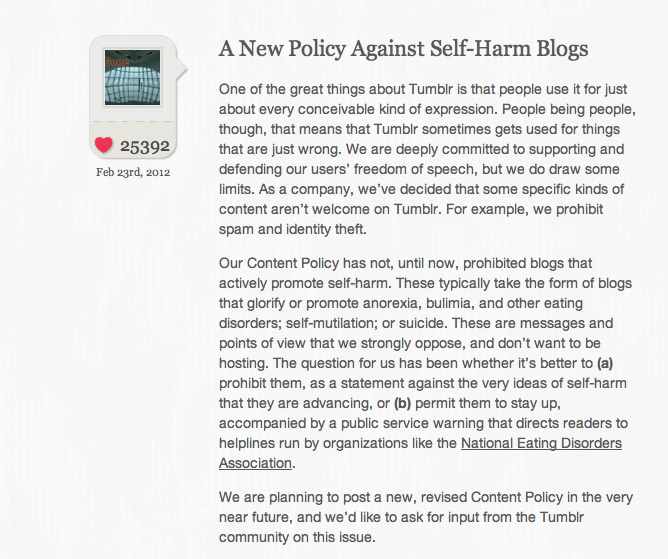Jackie Hartsough
Staff Writer
Tumblr announced a new policy Against Self-Harm Blogs on Feb. 23 that would ban blogs promoting self-mutilation, eating disorders and suicide. This announcement elicited over 25,000 responses in some form, ranging from support and gratitude to skepticism and outrage.
While almost everyone agrees that blogs should not be encouraging self-harm, many worry that a specific community of people who struggle with these issues are being targeted and banned from the website. Where will Tumblr draw the line between promotion of self-harm and expression of one’s feelings? Many fear that Tumblr is creating a hostile environment for those who are looking for a safe, and for many anonymous, a place to work through their struggles.
One concerned blogger commented, “It seems to me that prohibition won’t prevent people from engaging in these behaviors- it will just push them further underground and limit the number of ways other people can reach out to help them.”
Other members of the Tumblr community share this belief that banning certain blogs will only serve to alienate a group of people looking for support.
On March 1, Self-Injury Awareness Day, Tumblr issued a follow-up announcement in an effort to address the overwhelming response to their proposed policy. They thanked everyone for their feedback and addressed what they saw as the most common concern: What about writers who blog about their own self-harm, but do not promote it? What happens to them? Tumblr acknowledged this as a valid concern and said, “While we won’t allow blogs dedicated to triggering self-harm, we will not act against blogs engaged in discussion, support, encouragement, and documenting the experiences of those dealing with difficult conditions like anorexia, bulimia, and other forms of self-injury.”
Although they claim to have addressed the main concerns, I still have questions. How do they determine what a trigger is? Will they only ban blogs that say something like, “I’m anorexic, and you should be too,” or will they have some criteria for determining if a blog promotes self-harm? There is not one standard reason for self-injury; an individual could have any number of triggers, and they may be entirely different from those of the next person. So without a standard definition, how does Tumblr propose distinguishing between those “dedicated to triggering self-harm” and those “engaged in discussion?”
Tumblr claims that they are “not under the illusion that it will be easy to draw the line between blogs that are intended to trigger self-harm and those that support sufferers and build community,” but they say they will do their best.
How comforting.
They proposed a new plan, heard the critiques, realized it will be difficult, and have decided to move forward anyway. It is within their rights to alter their terms of service, and to be fair, this plan has widespread support. Of course, nobody will come out in support of self-harm, and nobody should. However, who will come out in support of the self-harmers? Tumblr’s new policy is an effort to help those who suffer from these disorders to have an easier time recovering, but many fear that they are losing a safe place to discuss what they are going through and feel singled out. Has Tumblr even listened to the community they are trying to help?












Comments are closed.